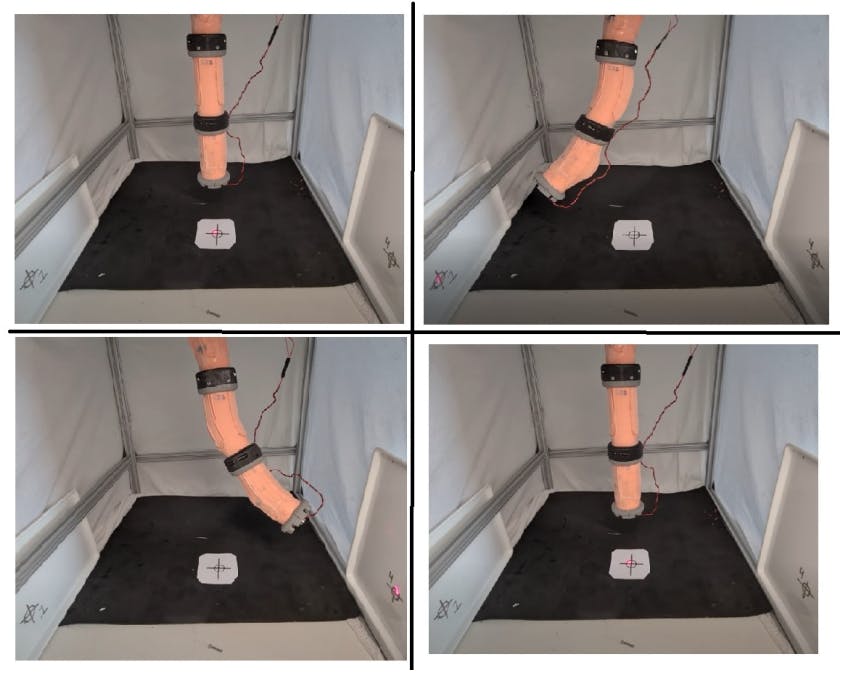Authors:
(1) Jorge Francisco Garcia-Samartın, Centro de Automatica y Robotica (UPM-CSIC), Universidad Politecnica de Madrid — Consejo Superior de Investigaciones Cientıficas, Jose Gutierrez Abascal 2, 28006 Madrid, Spain ([email protected]);
(2) Adrian Rieker, Centro de Automatica y Robotica (UPM-CSIC), Universidad Politecnica de Madrid — Consejo Superior de Investigaciones Cientıficas, Jose Gutierrez Abascal 2, 28006 Madrid, Spain;
(3) Antonio Barrientos, Centro de Automatica y Robotica (UPM-CSIC), Universidad Politecnica de Madrid — Consejo Superior de Investigaciones Cientıficas, Jose Gutierrez Abascal 2, 28006 Madrid, Spain.
Table of Links
Abstract and 1 Introduction
2 Related Works
2.1 Pneumatic Actuation
2.2 Pneumatic Arms
2.3 Control of Soft Robots
3 PAUL: Design and Manufacturing
3.1 Robot Design
3.2 Material Selection
3.3 Manufacturing
3.4 Actuation Bank
4 Data Acquisition and Open-Loop Control
4.1 Hardware Setup
4.2 Vision Capture System
4.3 Dataset Generation: Table-Based Models
4.4 Open-Loop Control
5 Results
5.1 Final PAUL version
5.2 Workspace Analysis
5.3 Performance of the Table-Based Models
5.4 Bending Experiments
5.5 Weight Carrying Experiments
6 Conclusions
Funding Information
A. Conducted Experiments and References
5.5 Weight Carrying Experiments
Finally, the load capacity of the robot and the performance of the kinematic model were evaluated and data was collected in vacuum, with different loads. For this purpose, an element similar to the joints between segments, also printed in PLA, was attached to the robot and different metal weights were placed on it. The device in question can be seen in Figure 20
The experiments consisted of taking PAUL to 10 different points in his workspace and comparing the position he reached with the position he would have reached if he had had no weight. The comparison was therefore made using the forward kinematic model, due to its greater accuracy. Four different weights were tested: 55, 90, 130 and 155 g. These values are similar to those used in other works in the field for totally soft
robots –excluding the hybrid ones, which, of course, have a much larger weight carrying capacity– [47, 61].
Figure 21 shows the results obtained. The mean errors are respectively 5.11, 4.40, 8.61 and 10.01 mm. From these data it can be deduced that, far from increasing progressively with weight, there are two categories: one that groups the experiments with loads of 55 and 90 g and another that groups those of 130 and 155 g. For the lower load values, the PAUL model predicts values with errors similar to those obtained by consulting the direct kinematics in the table obtained without weights. In the other cases, the results are clearly worse.
It can also be seen that the lower error values, however, are quite similar in all cases. This is due to the fact that, at the points closest to the centre of its working space, the manipulator is able to position itself with much less error, regardless of the weight it is carrying. What the load produces, therefore, is not a systematic increase in error but a decrease in the working space, as PAUL lacks the strength to reach the areas furthest from the centre with the extra weight.
Table 5 compares PAUL performance those achieved in other works. Although there is room for improvement, the results obtained here are better than those of the closed-loop control of [47], where the average error obtained is 2 cm, and to those of the wired manipulator of [61]. While the latter seems to be independent of load, PAUL sees its error increase with increasing weight, which seems to indicate that, at higher weights, PAUL will indeed underperform.
Two aspects remain to be analysed. On the one hand, to see if between 90 and 130 g the increase in error is progressive or if, on the contrary, there is a point that clearly divides the two groups. On the other hand, it would also be necessary to study how an improvement in the accuracy when empty would affect the accuracy when loaded: whether the robot would remain as accurate or whether these errors would not decrease.













